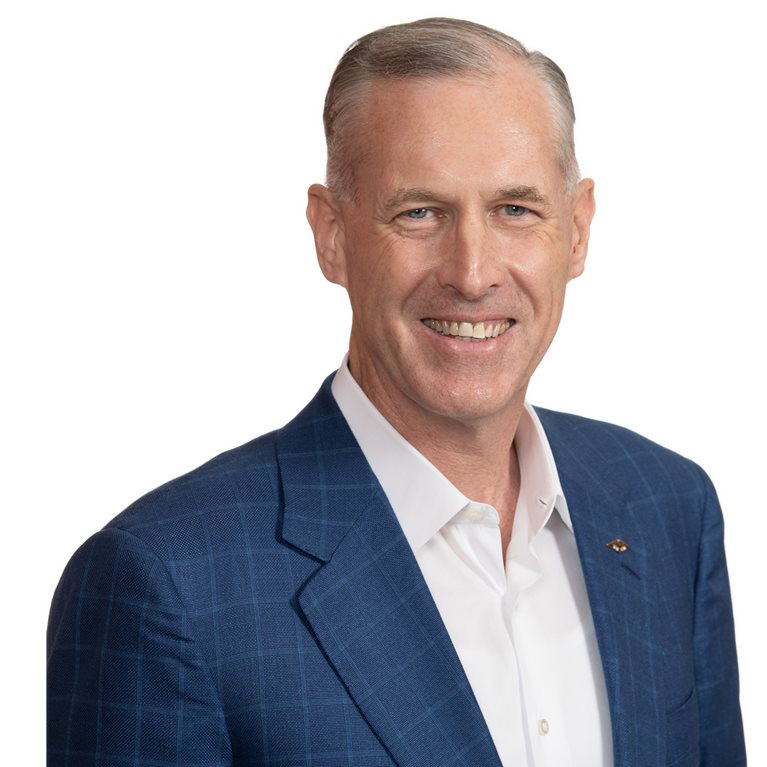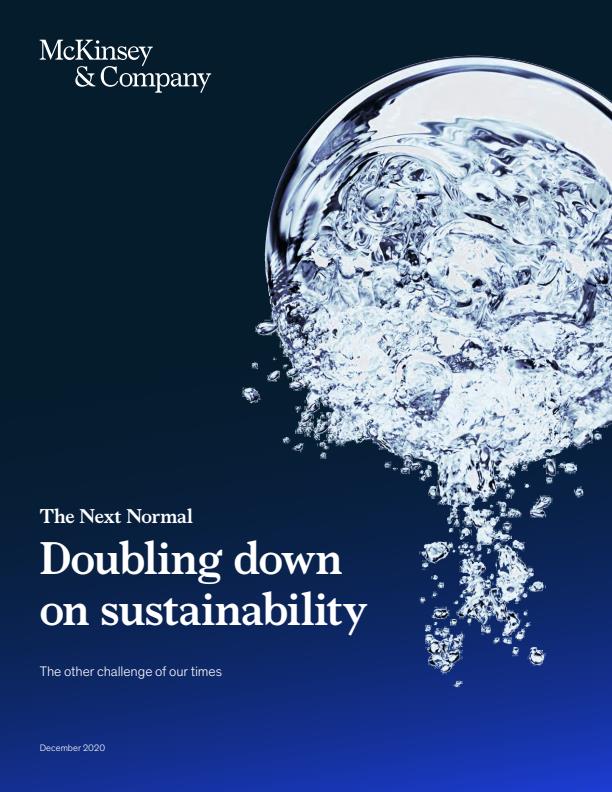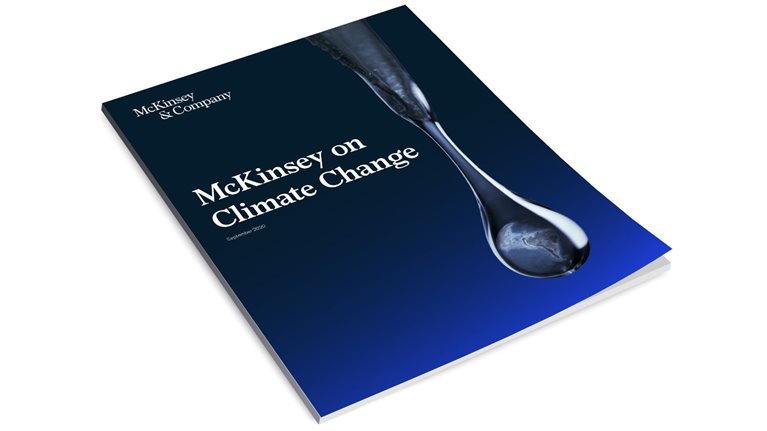When the world came to a standstill in the wake of the coronavirus outbreak, governments and businesses had to shift the focus of their agendas. Today, more than eight months after the shutdown, energy and resources are being poured into stopping the spread of the virus, and into repairing the economic, social, and emotional toll that the pandemic has wrought. Given the scope of this challenge—and the months, and even years, it could potentially take to address it—can the world afford to devote attention to climate change and the broader issue of sustainability?
It has to. The earth’s warming over the next decade is unavoidable, and with that reality comes an increased risk of physical and economic hazards. The only way to avoid the worst impacts of climate change post 2030 is to aggressively decarbonize our economy and our daily lives. Mitigating climate change through decarbonization is, therefore, a huge and necessary response. The emission goals of the Paris Agreement state that all parties will reduce their carbon footprint by more than 50 percent by 2030 and eliminate it by 2050.
“This is a unique time for companies on their sustainability journey, and the transition at large in the global economy,” says Dickon Pinner, senior partner and global leader of McKinsey & Company’s Sustainability Practice. “Doing nothing or doing just enough is not going to cut it. We have to act in this decade to avoid the most severe environmental and socioeconomic effects of a changing climate.”
Companies of all sizes are getting that message. Increasingly, business leaders and governments realize that responding to COVID-19 and addressing sustainability issues are not mutually exclusive efforts. Furthermore, smart investments in climate resilience and a lower carbon future are actually cost effective. Just look at the utility industry in the US: McKinsey research found that the average US utility company could save up to $1 billion over 20 years by investing in strengthening infrastructure and building resilience and adaptability through the use of microgrids and battery storage, for example, compared to the cost of repairing damage after it happens.
McKinsey research found that the average U.S. utility company could save up to $1 billion over 20 years by investing in strengthening infrastructure and building resilience and adaptability through the use of microgrids and battery storage, for example, compared to the cost of repairing damage after it happens.
Similar to the response needed to battle COVID-19, addressing sustainability in the broadest sense requires setting goals and creating a detailed road map for achieving them. The companies that are serious about this are focused on transitioning the real economy to be lower carbon at scale. The levers they’re using to get there? Reallocation of capital, innovation, resiliency, and transparency at every step of the way.
In the process, one thing is beginning to come into sharper focus, says Pinner. “For too long, companies, and governments for that matter, have been overexposed to the risks involved in climate change but underexposed to the opportunity,” he says. “It’s a colossal undertaking, but the 2020s are going to be the decade that proves whether the world will succeed or fail in meeting this critical challenge.”
The companies featured herein are taking decisive, massive, and transformative action. They understand the risks inherent in big, bold steps—but they’re equally aware of the danger of doing nothing or doing too little. And here’s something else: They’re not shy about saying that every company—big or small, legacy or disruptor—has a part to play and a contribution to make. That is not an easy mission, and it’s being made more complex by a ferocious global pandemic. But addressing climate change now is the only path to attaining a more prosperous, resilient and sustainable planet in the years ahead.
Climate change and plastic waste are among the biggest issues the world is facing, even in the midst of COVID-19, and our products and the technologies we’ve developed are crucial to addressing both.
Feeding the planet, sustainably
“The food system is broken,” says Emmanuel Faber, CEO of Danone, the French food and beverage giant. That’s a provocative statement coming from a food company executive whose brands include Évian water, Dannon yogurt, and International Delight coffee creamers, but it underscores Faber’s commitment to operating Danone in a way that connects the health of consumers with the health of the planet.

In 2017, the company unveiled a guiding vision entitled One Planet. One Health. Faber explains: “For the last 50 years, the food industry has worked to lower the cost of calories that we bring to people, and we’ve done it very successfully. But a parallel result of that is that we have increased obesity, diabetes, and monocropping that ruins soil health. We’re not preparing the next generation for a food system that works.”
To address the twin issues of obesity and food waste, the company has set ambitious sustainability targets for each of its product lines. It can now also determine the source location, sustainability standard, and environmental impact of its ingredients. In February, Danone announced a $2.3 billion climate acceleration plan, which over the next three years will overhaul the company’s agriculture, energy, operations, and packaging to generate more resilient and sustainable growth for its brands. Faber says the investment will go a long way in helping the company cut in half the amount of plastic its water brands use and achieving carbon neutrality in Europe by 2025.
Danone is also working toward becoming a Certified B Corp by 2025. B-Corp status verifies that a company has met a high set of social and environmental performance standards and transparency. The company’s North American operations achieved B-Corp status in 2018. “For us, climate is not an externality,” Faber says. “It’s part of the resilience of our business, so addressing it is not a question of philanthropy—it’s a question of smart business.”
For us, climate is not an externality. It’s part of the resilience of our business, so addressing it is not a question of philanthropy—it’s a question of smart business.
A ‘close to the core’ approach
When the world’s largest retailer decides to transform its operations to battle climate change, big things can happen. When it asks more than 60,000 suppliers to join that mission, the impact is enormous. Kathleen McLaughlin, chief sustainability officer at Walmart, says the retailer is leveraging its considerable sustainability know-how on “close to the core” areas: climate, nature, waste, and people. And while the pandemic has certainly presented its own set of challenges to businesses in nearly every corner of the globe, it has also underscored how powerful collective action can be, she says.

“One thing we’ve learned over the years, and certainly through the pandemic, is that there isn’t a trade-off between economic prosperity, social justice, and environmental sustainability,” McLaughlin says. “They all work together, and individual actions, even small ones, can have a meaningful impact.”
Within its own operations, the retail giant has committed to zero emissions by 2040 and 100 percent renewable energy by 2035. In its more than 10,000 stores, clubs, and distribution centers worldwide, nearly 30 percent of its electric needs now come from renewable energy, with a goal of 100 percent by 2035. And Walmart reports that it’s diverted an estimated 80 percent of its unsold products, packaging, and other operational materials from landfills and incineration globally, as part of its goal to generate zero waste in its operations.
The company also gets its massive network of suppliers involved. In 2017, it launched an ambitious initiative called Project Gigaton. The goal, McLaughlin explains, is to reduce 1 billion metric tons (a gigaton) of greenhouse gas emissions from the company’s supply chain by 2030. To put that number in perspective, consider that eliminating a gigaton of greenhouse gas emissions is the equivalent of taking 211 million passenger cars off the road for a full year, according to calculations by the Environmental Protection Agency (EPA). So far, she says, more than 2,300 of Walmart’s suppliers have signed on, and have reported that they’ve avoided 230 million metric tons of emissions through their own sustainability efforts in energy, packaging, agriculture, forests, waste, and packaging use and design.
One thing we’ve learned over the years, and certainly through the pandemic, is that there isn’t a trade-off between economic prosperity, social justice, and environmental sustainability. They all work together, and individual actions, even small ones, can have meaningful impact.
Closing the loop
Dow Inc. Chairman and CEO Jim Fitterling knows the impact his company—one of the world’s largest producers of plastics and packaging—has on the environment. So in January 2019, he decided to do something about it, directing Dow to become a founding member of the Alliance to End Plastic Waste, an initiative to accelerate efforts to—as the name makes clear—end plastic waste in the environment.

That dichotomy isn’t lost on Fitterling, who joined Dow in 1984, two weeks after graduating from the University of Missouri-Columbia. He’s spent his entire career at the company, witnessing its transformation from a low-margin, commodity business into one that’s focused on higher-growth, consumer demand-driven markets. Now he wants to take Dow further into the future by transforming the business into what he calls the “most sustainable materials science company in the world.”
A tall order, for sure, but it’s one that’s driven by a detailed plan with measurable goals and a commitment to accountability and transparency, he says. Fitterling explains that Dow’s new sustainability targets launched in June this year focus on three areas: protecting the climate, stopping the waste, and closing the loop. “Climate change and plastic waste are among the biggest issues the world is facing, even in the midst of COVID-19, and our products and the technologies we’ve developed are crucial to addressing both,” he adds.
When it comes to climate change, Fitterling says that by 2030 Dow will reduce its net annual carbon emissions by 15 percent from its 2020 baseline, and the company intends to be carbon neutral by 2050—in line with the goals of the Paris Agreement. On the plastics front, it will help “stop the waste” by enabling 1 million metric tons of plastic to be collected, reused, or recycled through its own actions or through partnerships by 2030.
“Clearly, the issue that’s front and center with plastic is the amount of it that winds up in the ocean,” Fitterling says. He says Dow’s commitment is substantial but is not enough to solve the problem alone. “We’re among the 25 top producers of plastic in the world by volume,” he says. “If every one of those other companies made this kind of commitment, we’d make a massive move toward stopping the plastic waste.”
On the plastics front, Dow will help “stop the waste” by enabling 1 million metric tons of plastic to be collected, reused, or recycled through its own actions or through partnerships by 2030.
But perhaps the biggest challenge is what Fitterling calls “closing the loop.” To meet that challenge, he says, Dow will make sure that by 2035 all of its products sold into packaging applications will be reusable or recyclable. “A lot of things that people buy or use are perfectly capable of being recycled but they’re not because there’s not a collection method,” he says. “Some of them are not at all capable of being recycled, so we want to make sure the whole product line can be recycled.”
The conversation isn’t about shutting down industries. It’s about how they transition to operate in a cleaner, more sustainable and resilient way that doesn’t continue to put humankind’s future on this planet at risk.
And while Fitterling concedes that the pandemic is at the top of everyone’s mind, he views the issues of climate change and plastic waste as no less critical. “We’re in a situation where the market has slowed down, but our scientists are still working on new technologies that are more sustainable and will address these longer-term issues,” Fitterling says. “When we come out of this pandemic, I want us to keep moving ahead on everything we’ve committed to doing.”
The changes required to successfully address climate change are huge, transformative, and ultimately essential. Every industry, government, and even individual has a role to play. “The conversation isn’t about shutting down industries,” Pinner says. “It’s about how they transition to operate in a cleaner, more sustainable and resilient way that doesn’t continue to put humankind’s future on this planet at risk.”
Go behind the scenes and get more insights with “Dickon Pinner: Why sustainability must be core to the post-pandemic recovery” from our New at McKinsey blog.


